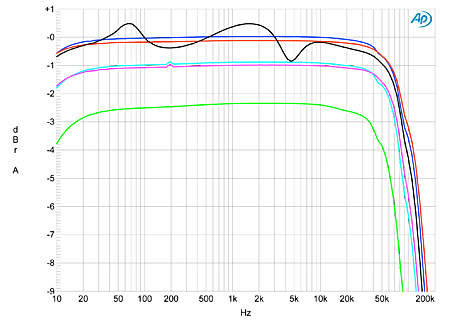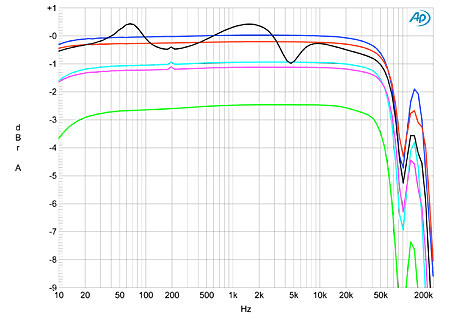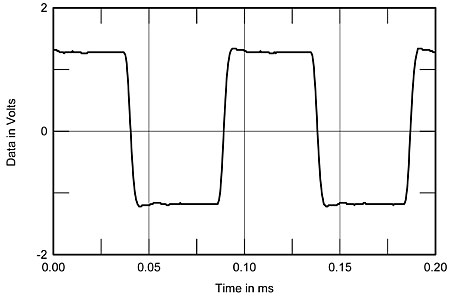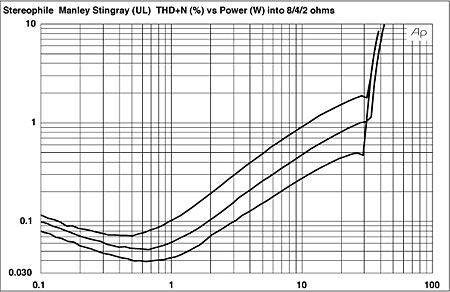| Columns Retired Columns & Blogs |
Manley Labs Stingray iTube integrated amplifier Measurements
Sidebar 3: Measurements
Footnote 1: It turned out that the crosstalk in this very early production sample was due to suboptimal wiring in the headphone circuit. Stingray iTubes manufactured after August 2009 have imoproved channel separation.—John Atkinson
I examined the measured behavior of Manley Labs' Stingray iTube using mainly Stereophile's loan sample of the top-of-the-line Audio Precision SYS2722 system (see the January 2008 "As We See It" and www.ap.com); for some tests, I also used my vintage Audio Precision System One Dual Domain.
I was at first confused by the fact that the iTube was on when all its lights were off, and in Standby when its front-panel blue light was on. Carefully reading the excellent manual sorted that out for me, and I began the testing by checking the bias of the eight EL84 output tubes. With no signal playing, you adjust each one's bias pot so that the DC voltage between its test point and ground is exactly 250mV, rechecking the earlier tubes' bias as you do so. As with other Manley amplifiers, the output stage can be run in Triode mode or in Ultralinear mode. I performed a full set of measurements in each mode.
Measured at the speaker terminals, the Stingray's maximum gain into 8 ohms was 37.1dB in Triode, 38.0dB in Ultralinear, a little higher than specified. In both modes, the iTube preserved absolute phase; ie, was non-inverting. The headphone output also preserved absolute polarity and offered a maximum gain of 17dB into 600 ohms. This was more than adequate for both my 2003-vintage iPod and 2008-vintage iPod Touch to drive the headphone output into clipping into 300 ohms with a 1kHz tone at –10dBFS. The maximum output from the headphone jack was 2.27V and the output impedance was a usefully low 5 ohms across the band.
The input impedance was to specification, at a moderate 12.4k ohms. The output impedance was usefully lower than specified, and lower than that of the original Stingray, at 1 ohm across the audioband in Triode, 1.1 ohms in Ultralinear. As a result, the variation in frequency response when driving our standard simulated loudspeaker was a moderate ±0.8dB (fig.1, gray trace). This graph was taken in Triode; note the excellent channel matching, the flat response within the audioband into higher impedances, and the smooth rolloff above 30kHz, with just a trace of a discontinuity around 100kHz. In Ultralinear (fig.2), the audioband behavior is almost identical but the ultrasonic rolloff is disturbed by a peak at 120kHz. This difference between the two modes can also be seen in the Stingray's reproduction of a 10kHz squarewave, with Triode (fig.3) showing just a hint of a leading-edge overshoot, which becomes fully developed in Ultralinear (fig.4), with two cycles of damped ringing visible.

Fig.1 Manley Labs Stingray iTube, Triode mode, frequency response at 2.83V into: simulated loudspeaker load (gray), 8 ohms (left channel blue, right red), 4 ohms (left cyan, right magenta), 2 ohms (green). (1dB/vertical div.)

Fig.2 Manley Labs Stingray iTube, Ultralinear mode, frequency response at 2.83V into: simulated loudspeaker load (gray), 8 ohms (left channel blue, right red), 4 ohms (left cyan, right magenta), 2 ohms (green). (1dB/vertical div.)

Fig.3 Manley Labs Stingray iTube, Triode mode, small-signal 10kHz squarewave into 8 ohms.

Fig.4 Manley Labs Stingray iTube, Ultralinear mode, small-signal 10kHz squarewave into 8 ohms.
Channel separation was somewhat asymmetrical, at 90dB R–L below 1kHz but 72dB L–R. Both figures smoothly decreased with increasing frequency, to 64 and 46dB, respectively, at 25kHz. As the left and right circuits are physically separated within the chassis, I assume the crosstalk creeps in via the shared volume control (footnote 1), which is based on a Cirrus chip controlled by a rotary encoder rather than the conventional pot used in the original Stingray. The wideband, unweighted signal/noise ratio, ref. 1W into 8 ohms and taken with the input shorted but the volume control set to its maximum, was modest, at 66.7dB in Triode, 67.7dB in Ultralinear. The A-weighted ratios were slightly better, at 74.7 and 75.7dB, but the amplifier's noise performance is compromised a little by the presence of 120Hz hum and its harmonics, which I could not eliminate by experimenting with the grounding between the iTube and the Audio Precision test set or by floating the Stingray's AC ground.
Manley specifies the Stingray iTube's maximum output power into a nonstandard 5 ohms rather than the usual 8 and 4 ohm loads, and at a nonstandard THD+noise figure of 1.5%. Using my usual definition of clipping as 1% THD+N, I measured 18Wpc into 8 ohms (12.55dBW) and 21Wpc into 4 ohms (10.2dBW) in Triode (fig.5). In Ultralinear, the iTube delivered 30Wpc into 8 ohms (14.8dBW) and 30.5Wpc into 4 ohms (11.8dBW) (fig.6), suggesting that Manley's specified powers of 18W into 8 ohms Triode and 32W Ultralinear are accurate. In both of these graphs, the distortion is at a minimum at outputs of a few hundred milliwatts; it rises steadily with increasing power until reaching actual waveform clipping, which suggests that only a modest amount of loop negative feedback is used in the iTube's circuit.

Fig.5 Manley Labs Stingray iTube, Triode mode, distortion (%) vs 1kHz continuous output power into (from bottom to top below 10W): 8, 4 ohms.

Fig.6 Manley Labs Stingray iTube, Ultralinear mode, distortion (%) vs 1kHz continuous output power into (from bottom to top below 10W): 8, 4 ohms.
Figs. 7 and 8 plot the small-signal THD+N percentage in the Manley's output against frequency. This generation of the Stingray appears to be considerably more linear in the midrange than the original, especially into higher impedances, with Ultralinear slightly better overall than Triode. However, the rise in distortion into 2 ohms in both graphs suggests that the amplifier is having to work hard into this impedance, even at the low signal level. The left channel shows more of a rise in THD at very low frequencies, suggesting that its output transformer is not quite as good as that used in the right channel. The rise in THD in the high treble visible in all the traces in these graphs is due to the circuit having less gain margin available in this region for the negative-feedback loop to work its mojo.

Fig.7 Manley Labs Stingray iTube, Triode mode, THD+N (%) vs frequency at 2.83V into: 8 ohms (left channel blue, right red), 4 ohms (left cyan, right magenta), 2 ohms (green).

Fig.8 Manley Labs Stingray iTube, Ultralinear mode, THD+N (%) vs frequency at 2.83V into: 8 ohms (left channel blue, right red), 4 ohms (left cyan, right magenta), 2 ohms (green).
The original Stingray offered a spectrum that was heavily second harmonic in nature; in contrast, the iTube version's signature is predominantly third harmonic (fig.9) in both output modes. At high powers, the right channel (fig.10, red trace) did have a little more second harmonic than the left (blue), with some higher-order harmonics apparent. Its decreasing linearity at high frequencies means that the Stingray didn't do as well as I would have liked on the demanding two-tone high-frequency intermodulation test, with Triode (fig.11) being slightly worse than Ultralinear. The 1kHz difference tone lay at –46dB (0.5%), with a regular series of higher-order intermodulation products visible. Of equal concern was the presence of supply-related spuriae at 120Hz and its harmonics, which can also be seen as sidebands around the primary tones. Again, I couldn't eliminate these by experimenting with grounding.

Fig.9 Manley Labs Stingray iTube, Ultralinear mode, 1kHz waveform at 2.1W into 4 ohms (top), 0.114% THD+N; distortion and noise waveform with fundamental notched out (bottom, not to scale).

Fig.10 Manley Labs Stingray iTube, Triode mode, spectrum of 50Hz sinewave, DC–10kHz, at 14W into 8 ohms (left channel blue, right red; linear frequency scale).

Fig.11 Manley Labs Stingray iTube, Triode mode, HF intermodulation spectrum, DC–24kHz, 19+20kHz at 12W peak into 8 ohms (linear frequency scale).
Manley Labs' Stingray iTube didn't do badly on the test bench for a relatively affordable tubed design and its design is well-sorted, as they say in the UK. The higher power and slightly better linearity of its Ultralinear output-stage operation is offset by the less stable squarewave behavior; perhaps that's why Erick Lichte preferred Triode mode.—John Atkinson
Footnote 1: It turned out that the crosstalk in this very early production sample was due to suboptimal wiring in the headphone circuit. Stingray iTubes manufactured after August 2009 have imoproved channel separation.—John Atkinson
- Log in or register to post comments




































